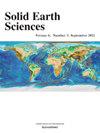基于指数模型的尼日利亚Nsukka沉积盆地部分地区地下水脆弱性评价
IF 2
4区 地球科学
Q3 GEOSCIENCES, MULTIDISCIPLINARY
引用次数: 0
摘要
尼日利亚Nsukka沉积盆地的地下水脆弱性评估对于确定风险地区、指导保护措施以及确保该地区依赖地下水的可持续水资源管理至关重要。利用地电性和水文地质指标对地下水污染脆弱性进行综合评价。通过垂直电测深(VES)来描绘地下岩性变化,同时确定孔隙度、导电性、渗透率和水力阻力等水文地质参数,以了解地下水流动动力学。探测结果显示了四到五个不同电阻率、厚度和深度的地电层,突出了地下的复杂性。这些砂层可分为红土砂、中粗棕砂、粗砂和细-中粗粒砂。研究区部分地区观测到的低电阻率表明受断层、裂缝等地质构造的影响。计算地下水脆弱性指数,包括含水层脆弱性指数(AVI)、GOD指数和GLSI指数,评价地下水对污染的敏感性。孔隙度、导电性、渗透率和水力阻力分别为27.04% ~ 30.21%、0.14 m/s ~ 0.15 m/s、1.98 ~ 2.20和93.07 ~ 665.89。该指数将研究区划分为高脆弱性和中等脆弱性两个等级,浅水区脆弱性较高。GOD和GLSI模型将研究区域划分为低和中等脆弱性等级。该研究为加强Nsukka沉积盆地的地下水管理提供了关键见解,确定了高脆弱性区域,并提出了保护措施、可持续土地利用和改善废水管理的建议。本文章由计算机程序翻译,如有差异,请以英文原文为准。
Evaluation of groundwater vulnerability using index-based model approach within parts of Nsukka Sedimentary Basin, Nigeria
Groundwater vulnerability assessment in Nsukka Sedimentary Basin, Nigeria, is essential for identifying at-risk areas, guiding protective measures, and ensuring sustainable water management due to the region's reliance on groundwater. This study presents an integrated assessment of groundwater vulnerability to pollution utilizing geoelectrical and hydrogeological indices. Vertical Electrical Sounding (VES) surveys were conducted to delineate subsurface lithological variations, while hydrogeological parameters such as porosity, hydraulic conductivity, permeability, and hydraulic resistance were determined to understand groundwater flow dynamics. The VES results revealed four to five geoelectric layers with varying resistivities, thicknesses, and depths, highlighting the complexity of the subsurface. These layers were classified as lateritic sand, medium-coarse brownish sand, coarse sand, and fine-medium coarse-grained sand. The low resistivity observed in parts of the study area suggests the influence of geological structures such as faults and fractures. Groundwater vulnerability indices including Aquifer Vulnerability Index (AVI), GOD index, and GLSI indexes were computed to assess susceptibility to pollution. Porosity, hydraulic conductivity, permeability, and hydraulic resistance were estimated and their values ranged from 27.04 % to 30.21 %, 0.14 m/s to 0.15 m/s, 1.98 to 2.20, and 93.07 to 665.89 respectively. The AVI classified the study area into high and moderate vulnerability classes, with regions of shallow water table exhibiting higher vulnerability. The GOD and GLSI models categorized the study area into low and moderate vulnerability classes. The study offers key insights for enhancing groundwater management in the Nsukka Sedimentary Basin by identifying high-vulnerability zones and recommending protective measures, sustainable land-use, and improved wastewater management.
求助全文
通过发布文献求助,成功后即可免费获取论文全文。
去求助
来源期刊

Solid Earth Sciences
GEOSCIENCES, MULTIDISCIPLINARY-
CiteScore
3.60
自引率
5.00%
发文量
20
审稿时长
103 days
 求助内容:
求助内容: 应助结果提醒方式:
应助结果提醒方式:


